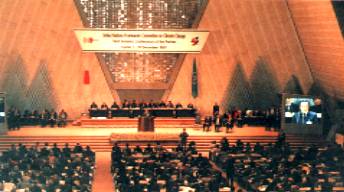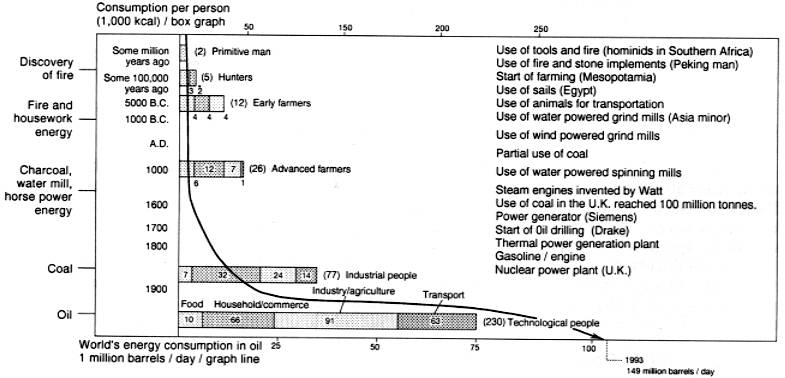Prologue :Quality of the Environment in Japan 1998
Prologue
1. Achievements of the Kyoto Conference on climate change and global warming, and the measures to be taken
Prior to the Kyoto Conference
It has gradually become clear that greenhouse gases such as carbon dioxide generated by human activities exert significant impacts on the global environment by rapidly warming the earth. In response to this threat, various countries started international discussions and negotiations, and as a result the Framework Convention on Climate Change was adopted in 1992. Among the provisions of this convention is that developed countries shall promise to reduce their greenhouse gas emissions to the 1990 level by the year 2000.
However, the promises made by the developed countries consisted of nothing more substantial than the establishment of a set of voluntary targets and no specific measures were decided upon regarding the period after the year 2000. In order to address this situation, in 1995, a decision was made to draw up another international agreement in 1997, the goals of which were to establish more specific targets regarding greenhouse gas emissions reduction by developed countries as well as to reach agreements on other related matters.
During the negotiations that preceded the new agreement, however, the participating countries could not reach a consensus on various points, and the solution of these points of disagreement between countries was left to the third session of the Conference of the Parties (COP3) of the Framework Convention on Climate Change, which was scheduled to be held in Kyoto in 1997.

Prime Minister Hashimoto making a speech at the COP3 in Kyoto
Kyoto Conference and the Kyoto Protocol
The Kyoto Conference started on December 1st 1997, but the conflicts among the parties continued. High -level negotiations by government ministers and various formal and informal discussions were held in order to find a breakthrough. Although discussions were prolonged and progressed with difficulty, the Kyoto Protocol was adopted finally on 11th December.
Main Contents of the Kyoto Protocol
| Numerical Targets of Annex I Parties (including the Process of Transition to a Market Economy) |
|---|
|
| Policies and Measures |
|
| Issues Regarding Developing Countries |
|
The development of Post-Conference domestic measures
Immediately following the Kyoto Conference, The Global Warming Prevention Headquarters was established within the Japanese government with the Prime Minister as its head. In January 1998, the Headquarters announced the comprehensive promotion of domestic policies concerning the problem of global warming. Some measures to be given priority were decided. In addition, the revised Law Concerning the Rational Use of Energy and the Bill for Promotion of Measures to Cope with Global Warming were submitted to the National Diet for approval. Furthermore, voluntary measures are being taken by related industries to reduce and control emissions of greenhouse gases.
Post Kyoto - Challenges and tasks as we move to the Twenty first Century
Looking at our future from the perspective of the achievements made at the Kyoto Conference, it can be concluded that, in order for developing countries which anticipate large increases in their own levels of greenhouse gas emission to hold back these emissions at an early stage of development, developed countries need not only to offer much support to developing countries but also to take the lead to show that it is possible to enjoy a higher quality of life while making major cuts in CO2 emission levels. In order to make this possible, however, it is essential for us to review the basis of our economic and social systems and to have a clear idea of the nature of society and the economy that will be realized in the 21st century.
2. Turning away from the paradigm of mass-production, mass-consumption and mass-disposal
The limits of current societies in the developed industrialized countries
Many ancient civilizations developed utilizing their rich forest resources, but as development proceeded and human population increased, the resources were depleted and the civilizations in turn declined and perished. Other civilizations were then born in other places and developed, and thus have human civilizations continued to thrive in different times and areas.
In the western (European) civilization, the Great Navigation Era ushered in a period of trading on a global scale. The dramatic increase in production that followed the Industrial Revolution greatly expanded the range of human activities. As a result of this expansion global warming has become a serious problem today, apparently affecting food and water resources, forest resources and other living species all over the world. Unlike the ancient civilizations, the environmental impacts of which were limited to certain areas on earth, our society (civilization) of the present day stands at a point of no return. The reason for this situation is that in a very short period of time we have been consuming natural resources, including fossil fuels, which have been generated and stored over millions, if not billions, of years.
At the same time we have been disposing of great quantities of wastes. These have exceeded the natural capacity of ecosystems to break down waste and have thus placed, and continue to place, huge pressure on the environment. In order to avoid such environmental load, it is necessary first to properly control and circulate substances generated by human activities and to reduce the burden on the environment. Secondly, by understanding the underlying mechanisms of nature which are the foundations upon which all human activities depend, it is necessary to transform our society, establishing an economic and social system that is based on the principles of "circularity" and "coexistence," wherein human activities can be harmoniously adjusted to suit the mechanisms of nature .
Towards the transformation of the economic and social system
For the purpose of transforming our economic society into a system based on circularity and coexistence, it is necessary to adjust our "technology" and "systems" just as we have overcome the problems of industrial pollution in the past with technological innovation and regulations.
However, for the solution of such problems as global warming which are largely caused by our daily lives and economic activities, it is essential to make a significant change not only to our technologies and policies but also to our "sense of values," which are the very basis of the present economic and social system relying on mass-production, mass-consumption and mass-disposal. It is we human beings that develop technologies and establish systems. If our sense of values can be changed, this itself will facilitate changes in technologies and systems. Also, in order to have the new sense of values shared with many people, various new systems and technologies need to be promoted simultaneously that will support the new sense of values. For example, the simultaneous improvement of education systems and the pursuit of technological development to change lifestyles can be implemented.
Historical Changes in the World's Energy Consumption 
| Primitive man: | East Africa, one million years ago. Food only |
|---|---|
| Hunters: | Europe, 100,000 years ago. Burned fuelwood for heat and cooking |
| Early farmers: | 5,000 BC in the fertile crescent. Cultivated crops and used domestic animals |
| Advanced farmers: | North and West Europe, 1,400 years ago. Used coal, water and wind power for heating and used domestic animals for transportation |
| Industrial people: | U.K. in 1875. Used steam engine |
| Technological people: | U.S.A. in 1970. Use of electric power and internal combustion engine. Food includes food for domestic animals. |
| Source: Environment Agency | |